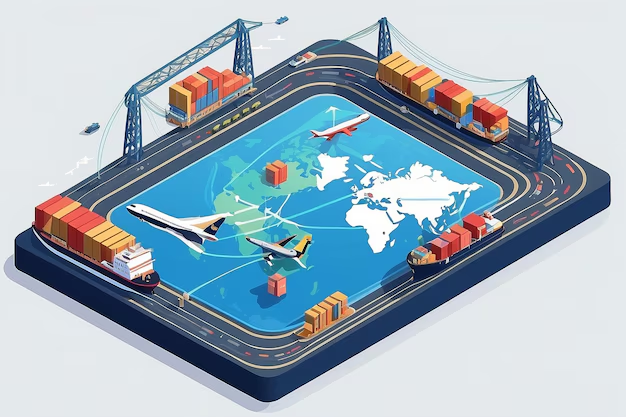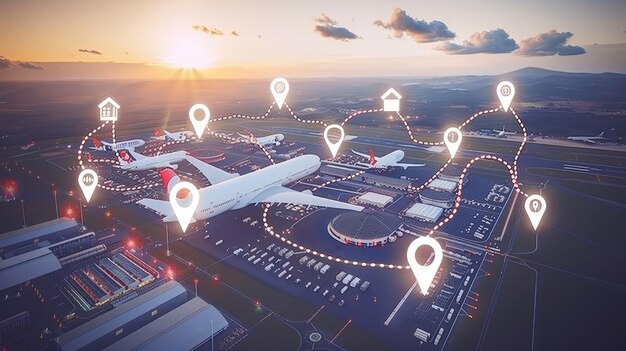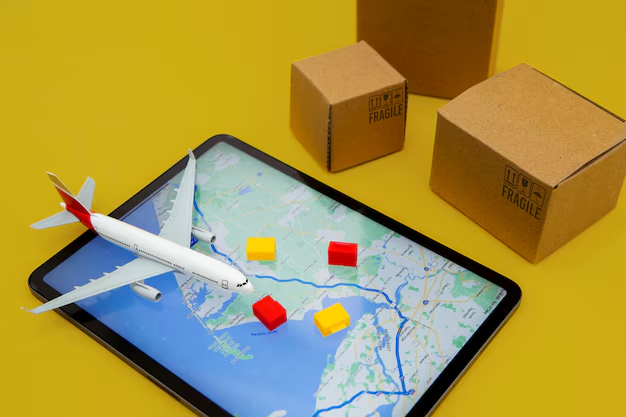
Table of Contents
In the global economy, air freight is now an essential component of almost all aspects of logistics.
With the growth of trade comes the heightening of people’s interest and the need to track such goods, and for that, real-time information is employed, helping ensure that goods are delivered properly to the last destination.
Hitech technology for air transfer monitoring tool development aims to achieve well-timed, correct, and comprehensive delivery information that benefits the shippers for all the activities regarding their products.
Shipment in the target location, the peak time of arrival and the estimated time of delay, if any.
With this real-time visibility, there were enhanced management capabilities concerning the supply chain, and problems were rapidly diagnosed and managed without losing customer loyalty.
Perishable products, expensive items like electronics, and even critical spare parts used are all packaged goods that need to be shipped timely. And it’s always enjoyable to know the exact location of the cargo.
Today, we will investigate in detail air freight tracking. We shall look at who the systems and controls are intended for and how they can be effectively implemented.
Air freight tracking also has more complex logistics issues, which are particularly common among shippers. Attempting to accomplish air freight tracking without air transportation inventions is an effort in futility.
What is the process of air freight tracking?

Air freight tracking is done by technological integration with the transport system incorporating GPS and RFID tags and barcode technologies to track the exact movements of the cargo in real time.
When goods such as bicycles or other commodities are spoiled, every item must be affixed with a number or code for digital linking.
Such added services include tracking the cargo from the point of departure and constant visibility of its current position and the expected arrival time at every intermediate step.
On the other hand, this information comes in handy to shippers and payers between pick-ups and deliveries at any time.
Tracking websites or cellphone applications help this information to be easily retried by the recipients and the suppliers by tracking the status of the cargo in real time.
Enhanced systems also allow for notifications in case of delays, customs, and other obstructions during the transport process.
Air freight tracking deals with uncertainty to a greater extent, improves communication and facilitates the streamlining of logistics for companies by providing this level of transparency.
It also helps resolve issues quickly, making disruption as short as possible. This system is particularly important for sensitive and urgent cargo like medical equipment and foodstuffs where time wastage can lead to negative outcomes.
Why is real time tracking necessary in air freight?

Real-time tracking is very important in air freight since it guarantees precision, accountability and assurance. They can do so since they can keep track of the status and position of the shipment within the sub-period.
For instance, a shipper can decide to provide new estimated delivery timelines or notify the end customers when there is a hold-up at customs or when there has been a bad spell of weather.
The one aids in evading contradictory messages from the company to the customers and helps maintain their trust in the firm.
Timely tracking helps inventory management as well. This information can also be applied in determining how much stock to keep or when to schedule production making timelines to avoid costly breakdowns.
It also helps reduce the risks of loss, theft, or damage since constant surveillance will make it easy to find the consignment and act on the situation.
In the case of industries with a considerable value addition aspect or industries where the goods have a shorter lifespan, for example, pharmaceuticals and electronics, real-time tracking goes a long way to ensure that the proper disposition of the cargo is followed.
This visibility solves the operational gaps and enhances customer service through constant and precise communication.
What are the common challenges in air freight tracking?

identifies potential weaknesses in most air freight tracking systems and processes. One such drawback is the dilution of unity in the tracking information.
This problem is especially critical when two or more air328 freight logistics companies operate on the same cargo within different geographies. In this instance, the information may fail, and shipment visibility may be hampered.
Other challenges include inadequate information on real-time tracking in places depending on the particular outer mediums; for example, GPS, as technology may not work effectively.
Also, there are reports where several latent transportation means are taken up for the completion of the trip, so tracking the track continuing becomes difficult if the coordination between the different locative systems fails to failsafe cooperate.
In some countries, even when the tracking might be feasible, governmental policies may impede the available tracking level. Moreover, such solutions to track are so complicated that they even choose not to decide to use them, thus resulting in various discrepancies.
However, these problems can be solved by working with reliable outsourcing companies, using multi-faceted and complex tracking systems encompassing more than one node of the worldwide supply chain and adhering to the relevant legal requirements of any key region.
What is a practical way to pick an appropriate air freight tracking system?

Air freight tracking systems can be defined and categorized according to different requirements and all the characteristics that will define the operations, including the volumes of shipments, types of goods, and details of the moving process.
When seeking what type of system to select, it is preferable to acquire one that provides information about the movement of goods over the Internet, is compatible with other systems along the supply chain, and is easy to use.
In addition, it will also need to be tailored to your specific shipping requirements. For example, some companies wish to gather extra information on temperature control for sensitive goods; others would need multi-modal tracking of goods where air and road transportation is used.
In what ways does the availability of air freight tracking assist the customers?

In air freight transportation, one factor contributing to customer satisfaction is the transparency and reliability extended by the tracking system throughout the shipping process.
Customers who make orders, especially if they are international and time-confined, demand progress on where their orders are.
Air freight tracking enables firms to offer tracking information on the goods, including where they are, when to expect them, what might delay arrival,l and what issues may arise.
Such a level of transparency develops confidence between businesses and customers. Customers like those subscribing to a shipment service will appreciate it when they know the shipment is on schedule and arriving in good time.
It also enables them to respond to requirements promptly and mitigates unpleasant situations, including overdue deliveries or misplaced mail.
With air freight tracking, companies preemptively deal with a customer with delays by directly informing them and providing options such as adjusted delivery times.
This helps retain customers’ satisfaction with the company even when some expectations are unmet.
Further, because the status of the shipment can be updated in real-time, there is less need for customers to call customer service to find out about the order, which improves overall customer satisfaction.
Service-oriented companies know that implementing an efficient air freight tracking system will help win customers and ensure return business.
The ability to ensure accurate details and manage challenges through tracking will help you learn about the business.
FAQ’s
Is there tracking on freight?
Yes, freight tracking is a very common tool shippers use to help them as they can view the progress made on cargo in terms of the transportation cycle.
What is freight tracking?
It is a system of monitoring the location and the condition of the shipped items to and from the customers.
How can I track my freight?
You can track the freight using the tracking number allocated to you by the shipping firm on the website or the software application that gives real-time information.
Why is freight tracking important?
Tracking and tracing goods in freight transportation promotes visibility, increases communication efficiency, and provides better control of when the goods will be delivered to customers.
Conclusion
When all movements of airfreight are tracked, the efficiency in the logistics flow of goods within the business is improved and, thus, the clients’ satisfaction.
Thus, if the customers can see the information about the company’s offers, they can act and do something to help build the business. This is because, apart from quickening the processes, deploying appropriate tracking solutions assists in customer relationship building.

